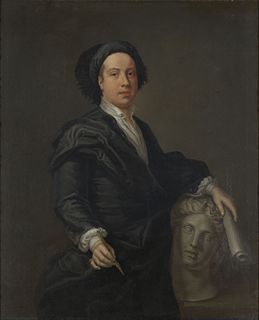
William Kent was an eminent English architect, landscape architect, painter and furniture designer of the early 18th century. He began his career as a painter, and became Principal Painter in Ordinary or court painter, but his real talent was for design in various media.

Stourhead is a 1,072-hectare (2,650-acre) estate at the source of the River Stour in the southwest of the English county of Wiltshire, extending into Somerset. The estate is about 4 km northwest of the town of Mere and includes a Grade I listed 18th-century Palladian mansion, the village of Stourton, gardens, farmland, and woodland. Stourhead has been part-owned by the National Trust since 1946.

Eaton Hall is the country house of the Duke of Westminster. It is 1 mile (2 km) south of the village of Eccleston, in Cheshire, England. The house is surrounded by its own formal gardens, parkland, farmland and woodland. The estate covers about 10,872 acres (4,400 ha).

Prior Park Landscape Garden surrounding the Prior Park estate south of Bath, Somerset, England, was designed in the 18th century by the poet Alexander Pope and the landscape gardener Capability Brown, and is now owned by the National Trust. The garden was influential in defining the style known as the "English landscape garden" in continental Europe. The garden is Grade I listed in the Register of Historic Parks and Gardens of special historic interest in England.
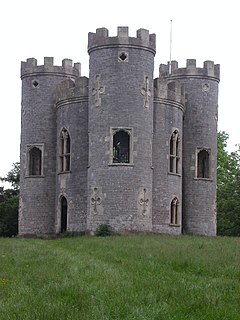
Blaise Castle is a folly built in 1766 near Henbury in Bristol, England. The castle sits within the Blaise Castle Estate, which also includes Blaise Castle House, a Grade II* listed 18th-century mansion house. The folly castle is also Grade II* listed and ancillary buildings including the orangery and dairy also have listings. Along with Blaise Hamlet, a group of nine small cottages around a green built in 1811 for retired employees, and various subsidiary buildings, the parkland is listed Grade II* on the Register of Historic Parks and Gardens of special historic interest in England.
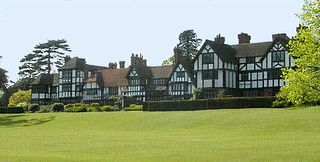
Tudor Revival architecture first manifested itself in domestic architecture in the United Kingdom in the latter half of the 19th century. Based on revival of aspects that were perceived as Tudor architecture, in reality it usually took the style of English vernacular architecture of the Middle Ages that had survived into the Tudor period. The style later became an influence elsewhere, especially the British colonies. For example, in New Zealand, the architect Francis Petre adapted the style for the local climate. In Singapore, then a British colony, architects such as R. A. J. Bidwell pioneered what became known as the Black and White House. The earliest examples of the style originate with the works of such eminent architects as Norman Shaw and George Devey, in what at the time was thought Neo-Tudor design.

Elvaston Castle is a stately home in Elvaston, Derbyshire, England. The Gothic Revival castle and surrounding parkland is run and owned by Derbyshire County Council as a country park known as, Elvaston Castle Country Park. The country park has 200 acres (0.81 km2) of woodlands, parkland and formal gardens.

The term ferme ornée as used in English garden history derives from Stephen Switzer's term for 'ornamental farm'. It describes a country estate laid out partly according to aesthetic principles and partly for farming. During the eighteenth century the original ferme ornée was Woburn Farm, made by Philip Southcote, who bought the property in 1734. William Shenstone's garden at The Leasowes was also a ferme ornée. Marie Antoinette made a later example at Versailles in the form of the Hameau de la Reine, created between 1783 and 1787, but it was much more for pleasure than for food production. The Dessau-Wörlitz Garden Realm was said to be the largest ferme ornée in 18th-century Europe. The most complete surviving example is said to be Larchill near Kilcock, Ireland.

Luscombe Castle is a country house situated near the resort town of Dawlish, in the county of Devon in England. Upon purchasing the land at Luscombe in 1797, Charles Hoare demolished the existing house and commissioned architects John Nash and Humphrey Repton to design a new house and gardens at the site. Nash and Repton came up with an asymmetrical designed building made from Portland stone, with castellated parapets, turrets and pinnacles to create the feel of a picturesque castle.

Houghton is a small village and civil parish in the Test Valley district of Hampshire, England. The village is situated alongside the River Test. Its nearest town is Stockbridge, which lies approximately 1.8 miles (3 km) to the north-east. The village is a dispersed linear settlement, mostly strung out along the single road through the village, which broadly follows the course of the River Test north-south. Houghton is dominated by substantial agricultural/sporting estates at each end, the Houghton Lodge estate to the north and the Bossington estate to the south. Each owns a number of properties in the village.
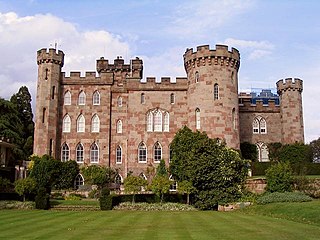
Cholmondeley Castle is a country house in the civil parish of Cholmondeley, Cheshire, England. Together with its adjacent formal gardens, it is surrounded by parkland. The site of the house has been a seat of the Cholmondeley family since the 12th century. The present house replaced a timber-framed hall nearby. It was built at the start of the 19th century for George Cholmondeley, 1st Marquess of Cholmondeley, who designed most of it himself in the form of a crenellated castle. After the death of the Marquess, the house was extended to designs by Robert Smirke to produce the building in its present form. The house is designated by English Heritage as a Grade II* listed building.

Tong Castle was a very large mostly Gothic country house in Shropshire whose site is between Wolverhampton and Telford, set within a park landscaped by Capability Brown, on the site of a medieval castle of the same name.

Strawberry Hill House—often called simply Strawberry Hill—is the Gothic Revival villa that was built in Twickenham, London by Horace Walpole (1717–1797) from 1749 onward. It is the type example of the "Strawberry Hill Gothic" style of architecture, and it prefigured the nineteenth-century Gothic Revival.

Cottage orné dates back to a movement of "rustic" stylised cottages of the late 18th and early 19th centuries during the Romantic movement, when some sought to discover a more natural way of living as opposed to the formality of the preceding Baroque and Neoclassical architectural styles. English Heritage define the term as "A rustic building of picturesque design." They often feature well-shaped thatch roofs with ornate timberwork.

Endsleigh Cottage is a country house near Milton Abbot, about 6 miles NW of Tavistock, Devon in England. It is a Grade I listed building. The gardens are Grade I listed in the National Register of Historic Parks and Gardens. The house was built in the early 19th century for the Duke of Bedford. Today, it is a hotel.

Radnor House was a 17th-century house on the banks of the River Thames in Cross Deep, Strawberry Hill, 0.5 miles (0.80 km) south of Twickenham town centre. It was destroyed by a bomb in 1940, and the remains of house and grounds form part of present-day Radnor Gardens.

Pope's villa was the residence of Alexander Pope at Twickenham, then a village west of London in Middlesex. He moved there in 1719 and created gardens and an underground grotto. The house and grotto were topics of 18th- and 19th-century poetry and art. In about 1845, a neo-Tudor house known as Pope's Villa was built on approximately the same site; it has been used as a school since the early 20th century. Pope's Grotto, which is listed Grade II* by Historic England, survives and is occasionally open to the public.

The Chapel in the Wood is a chapel in the grounds of St Mary's University on Waldegrave Road in the Strawberry Hill part of Twickenham, London. The chapel is an example of early Gothic Revival architecture and is a Grade I listed building.

Shotover Park is an 18th-century country house and park near Wheatley, Oxfordshire, England. The house, garden and parkland are Grade I-listed with English Heritage, and 18 additional structures on the property are also listed. Shotover House, its gardens, parkland and the wider estate are privately owned by the Shotover Trust. Shotover Park which lies on the north and east slopes of Shotover hill should not be confused with the more recently named Shotover Country Park, which is a public park and nature reserve on the southwest slopes of Shotover hill managed by Oxford City Council.
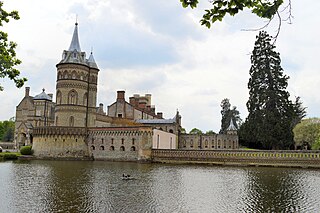
Horsley Towers, East Horsley, Surrey, England is a country house dating from the 19th century. The house was designed by Charles Barry for the banker William Currie. The East Horsley estate was later sold to William King-Noel, 1st Earl of Lovelace who undertook two major expansions of the house to his own designs. Lovelace lived at the Towers with his wife, Ada, daughter of Lord Byron, a pioneering mathematician, friend of Charles Babbage and described as among the first computer programmers. In 1919, the Towers was purchased by Thomas Sopwith, the aviator and businessman, who named his plane, the Hawker Horsley, after his home. Now a wedding and conference venue, Horsley Towers is a Grade II* listed building.



































